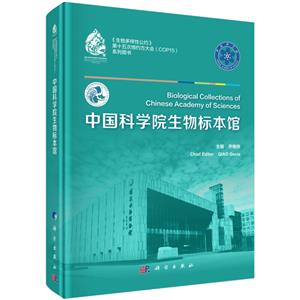-
>
宇宙、量子和人類心靈
-
>
氣候文明史
-
>
南極100天
-
>
考研數學專題練1200題
-
>
希格斯:“上帝粒子”的發明與發現
-
>
神農架疊層石:10多億年前遠古海洋微生物建造的大堡礁
-
>
聲音簡史
中國科學院生物標本館 版權信息
- ISBN:9787030686886
- 條形碼:9787030686886 ; 978-7-03-068688-6
- 裝幀:一般膠版紙
- 冊數:暫無
- 重量:暫無
- 所屬分類:>
中國科學院生物標本館 內容簡介
中國科學院生物標本館包括隸屬于中國科學院19個科研機構的20家生物標本館(博物館),是我國動物、植物、菌物及化石等標本保藏、研究和科學教育的主要實體場館,是國家科技資源兩個共享服務平臺——國家動物標本資源庫和國家植物標本資源庫的牽頭單位。中國科學院生物標本館的標本藏量、管理和利用,代表著我國戰略生物資源的整體水平,在國家生物資源的保護與可持續利用中具有不可替代的重要作用,對國家生物安全發揮了重要的支撐與保障作用。本書闡述了中國科學院生物標本館的發展歷史,以及各收藏機構的基本概況,總結了近年來其在戰略生物資源收集和保藏、服務科研支撐和國家需求等方面所取得的各項成果,并分析了生物標本館的未來發展趨勢。
中國科學院生物標本館 目錄
序
1 引言 2
2 經典分類與生物標本館 4
2.1 現代生命科學中的經典分類 4
2.2 生物標本和標本館 6
2.3 中國生物標本館的發展歷程 10
2.4 中國科學院生物標本館的貢獻 12
3 中國科學院生物標本館現狀 18
3.1 中國科學院生物標本館概況 18
3.2 中國科學院生物標本收藏 18
3.3 中國科學院生物標本館介紹 24
4 近年來工作進展和成果 124
4.1 戰略生物資源收集和保藏 124
4.2 科研支撐 144
4.3 服務國家需求 192
4.4 科學教育 210
4.5 新技術的應用 234
5 生物標本館的未來發展趨勢 240
5.1 持續開展生物標本資源收集和國際合作,增加館藏數量和范圍 242
5.2 推進標本信息數字化,深入挖掘資源價值 242
5.3 加強對已有資源的整合,統一管理 242
5.4 生物標本館運行模式的改變 244
主要參考文獻 246
Contents
Foreword
1 Introduction 2
2 Classical taxonomy and biological collections 4
2.1 Classical taxonomy in modern life science 5
2.2 Biological specimen and collections 7
2.3 The development course of Chinese biological collections 11
2.4 The contribution of the biological collections of CAS 13
3 Current situation of Biological Collections of the Chinese Academy of Sciences 18
3.1 A survey of CAS biological collections 23
3.2 Biological specimen collection of Chinese Academy of Sciences 23
3.3 Introduction to the CAS biological collections 25
4 Progress and achievements in recent years 124
4.1 Collection and preservation of strategic biological resources 125
4.2 Scientific research supports 145
4.3 Serving national needs 193
4.4 Science education 209
4.5 Application of new technology 233
5 Future development trend of biological collections 240
5.1 Continue to collect biological specimen resources and international cooperation to increase the number and scope of the collections 241
5.2 Promote the digitization of specimen information and dig the value of resources 241
5.3 Strengthen the integration and unified management of existing resources 243
5.4 The change of operation mode of biological collections 243
References 246
中國科學院生物標本館 節選
1 引言 Introduction 生物標本是自然界各種生物的*真實、*直接的表現形式和實物記錄,是生物學研究領域的重要素材,在分類學、系統學、生態學等各個分支學科中都有著十分重要的地位。同時,生物標本在許多領域都為社會帶來利益,包括生物安全、藥物研發、公共衛生和安全、環境變化監測以及傳統分類學和系統學研究等。 生物標本館則是長久妥善保存這些記錄的場館,其建立的目的就是讓生物標本的收藏范圍不斷擴大、保存時間不斷延長,從而為科研提供多種多樣的研究材料,為社會大眾展示千姿百態的自然生命,為國民經濟建設和國家生物安全提供資源保障。 中國的生物標本收藏與生物標本館孕育于19世紀,起步于20世紀初,發展于中華人民共和國成立之后。其中*重要、保藏標本數量*多的是隸屬于中國科學院系統的標本館。 中國科學院生物標本館是國家動物、植物、菌物、化石等標本保藏、研究和科學教育的重要實體,是全國生物標本集中保藏的*主要場所,在國家生物資源的保護與可持續利用中具有不可替代的重要作用。截至2019年底,中國科學院共有20個生物標本館(博物館),隸屬于19個研究所,保藏各類生物標本共計2141.5萬號,其中定名標本占一半以上,近一半標本完成了數字化工作。 自2014年以來,中國科學院生物標本館取得了一系列可喜的成績:在戰略生物資源收集與保藏方面,配合國家重大研究計劃,各館開展針對性考察和采集,共組織國內或國際合作考察1400余次,采集標本317.3萬號;在服務國家戰略方面,標本館參與國家重大戰略、重大研究計劃和國門生物安全建設,“十三五”以來各館主持或者支撐的院內外項目共計491項,經費達5.7億元,對科研工作發揮了巨大的支撐作用;在經典分類及生物物種資源研究方面,共鑒定標本103萬余號,顯著提升了館藏水平,還支撐了5600余篇論文和230余部專著的發表,對中國生物物種資源研究發揮了重要作用;在公眾教育與科普服務方面,共舉辦2000余場各類科普活動,受眾達446萬余人次,提供社會咨詢服務1.8萬余人次,發表科普著作80余部、科普文章700余篇,得到了社會各界的高度認可。 但與發達國家相比,我國在標本收藏、管理及可持續利用方面還有差距。未來將在中國科學院的領導下,建立中國科學院生物標本館分類管理體系;依托國家科技資源共享服務平臺,建設集生物標本收集、保藏、研究、支撐與科普為一體的國家生物標本資源共享服務平臺;依托“國家動物標本資源庫”和“國家植物標本資源庫”,以標本收集、保存、鑒定、研究為主要內容,繼續服務國家重大項目;針對“一帶一路”國家、全球生物多樣性熱點地區,開展聯合考察與研究、資源共享、人才培養等國際合作;加強標本館自身能力建設,提升支撐科技創新能力,構建合理的人才隊伍,確保體系的可持續發展。 The biological specimen is the most real and direct manifestation and physical record of all kinds of creatures in nature. It is an important material in the field of biological research, and plays an important role in taxonomy, systematics, ecology and other branches. At the same time, biological specimens bring benefits to society in many fields, including biosafety, drug research and development, public health and safety, environmental change monitoring and traditional taxonomic and systematic research. The biological collection is a long-term and proper venue for keeping these records. The purposes of its establishment are to make the collection of biological specimens continue to expand and the preservation time continue to extend, so as to provide a variety of research materials for scientific research, show a variety of natural lives for the public, and provide resource guarantee for national economic construction and national biosafety. China’s biological specimens and collections were conceived in the 19th century, started in the early 20th century, and developed after the founding of the People’s Republic of China. Among them, the most important and the largest number of specimens are the collections affiliated to the Chinese Academy of Sciences. As an important entity of national animal, plant, fungus, fossil and other specimen preservation, research and scientific education, the biological collections of the Chinese Academy of Sciences are the most important place for centralized preservation of national biological specimens, which plays an irreplaceable role in the protection and sustainable utilization of national biological resources. By the end of 2019, there are 20 biological collections / museums under the Chinese Academy of Sciences, belonging to 19 institutes, and a total of 21.415 million biological specimens were preserved, more than half of which had been identified and nearly half of which had been digitized. Since 2014, the biological collections of the Chinese Academy of Sciences has made a series of gratifying achievements: In terms of strategic biological resources collection and preservation, in cooperation with the national major research plan, each collection has carried out targeted investigation and collection, organized more than 1,400 domestic and international cooperative investigations, collected 3.173 million specimens. In terms of serving the national strategy, the collections have participated in the major national strategy and research plan, and national biosafety construction, and since the 13th Five-Year Plan, there have been 491 internal and external projects presided over or supported by collections / museums, with a total funding of 570 million yuan, which has played a huge supporting role in scientific research. In terms of classical taxonomy and biological species resource research, more than 1.03 million specimens have been identified, which has significantly improved the collection level, supported more than 5,600 papers and more than 230 monographs and played an important role in China’s biological species resources research. In terms of public education and popular science services, more than 2,000 various popular science activities have been held, with an audience of more than 4.46 million people, providing social advisory services for more than 18,000 people, and more than 80 popular science works and 700 popular science articles were published, which have been highly recognized by the society. However, compared with developed countries, there is still a gap in specimen collection, management and sustainable utilization in China. In the future, under the leadership of the Chinese Academy of Sciences, the classification management system will be established.
- >
李白與唐代文化
- >
姑媽的寶刀
- >
上帝之肋:男人的真實旅程
- >
伯納黛特,你要去哪(2021新版)
- >
莉莉和章魚
- >
苦雨齋序跋文-周作人自編集
- >
巴金-再思錄
- >
羅曼·羅蘭讀書隨筆-精裝














